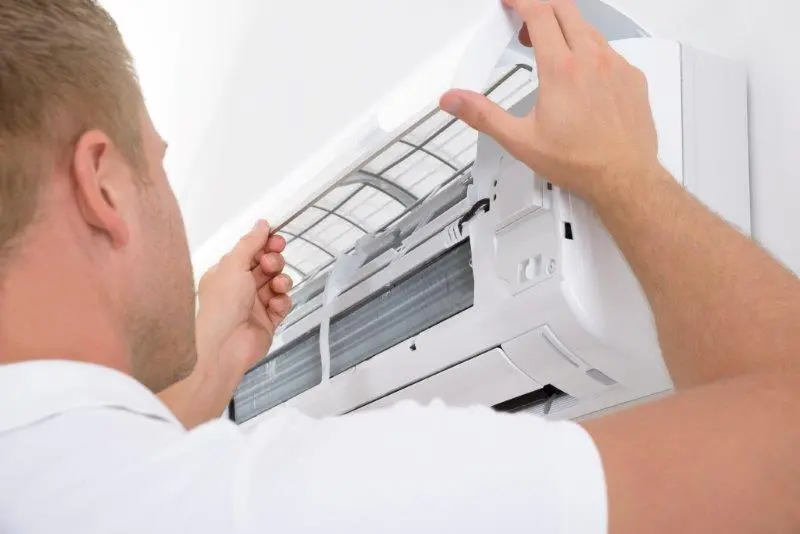Consider the Room Layout and Size:
Take precise measurements of the room and its dimensions before putting in your wall-mounted air conditioner. Think about things like the room’s square footage, height, insulation, and the quantity of doors and windows. For optimal performance, the cooling capacity may need to be adjusted according to these criteria.
Installing the air conditioner in the middle of the room will allow for more uniform cooling. Because of the potential impact on its efficiency and performance, keep the device away from heat sources such as direct sunlight, ovens, or electronics. Think about the room’s airflow pattern as well. Before turning on the air conditioner, be sure nothing, like curtains or furniture, hinders the airflow. The key to constant cooling and the elimination of hot spots is good ventilation.
Choose the Right Height:
Your wall-mounted air conditioner’s effectiveness and efficiency may be affected by the height at which it is installed. The standard recommendation is to mount the device around 7 or 8 feet off the ground. The room’s ventilation and the distribution of cold air are both enhanced by this height. Uneven cooling and decreased efficiency can occur from installing the air conditioner at an improper height.
Cool air can gather near the ceiling and hot air will stay near the floor if the unit is placed too high. On the contrary, if you set it up too low, furniture or other objects could block the airflow, rendering the device ineffective. Accessibility for cleaning and maintenance should also be considered while deciding on the installation height. For regular maintenance like checking and cleaning the filters, make sure the unit is easily accessible.
Ensure Proper Drainage:
For your wall-mounted air conditioner to work well, proper drainage is crucial. Condensate is a byproduct of cooling, and most air conditioners have a drainage system already installed to get rid of it. Making sure that the drainage system is in good working order and channelling the condensate away from the unit and its surroundings is crucial. Be careful to slightly tilt the AC unit downward toward the outside when you install it.
This prevents water from collecting inside the unit or seeping into the room by facilitating the correct drainage of condensation. Also, to collect any extra condensation, you might want to put a drip tray or drain pan under the air conditioner. If you want to keep your unit and the structures around it in good repair, you should check the drainage system often for obstructions and fix them as soon as you find them.
Hire a Professional Installer:
Even while it’s tempting to save money by installing your wall-mounted air conditioner yourself, it’s highly recommended that you employ a professional. Making sure the unit is placed correctly and is working properly is the job of a skilled technician. In order to determine the best location for maximum performance and efficiency, professional installers can evaluate your unique requirements.
In addition to lowering the possibility of harm, they may make sure the installation follows all applicable safety rules and building laws. If you want your air conditioner to last as long as possible and work as efficiently as possible, it’s best to have a professional handle the installation. If you want your wall-mounted air conditioner to last for years with minimal maintenance and maximum efficiency, it’s worth the investment to have a professional install it.
Consider Noise Levels:
When turned on, wall-mounted air conditioners can make a lot of noise, which can be bothersome during peaceful times or while you’re trying to get some sleep. Take into account the unit’s noise output and its closeness to rooms with high noise sensitivity, including bedrooms or study areas, when deciding where to install it.
Also, think about getting a model that has noise-reducing features like sound-dampening insulation or cutting-edge compressor technology. With these additions, you can keep the noise level down and the temperature up in your home with a wall-mounted air conditioner.
Ensure Proper Electrical Wiring:
To ensure the safe and efficient operation of your wall-mounted air conditioner, it is essential to use proper electrical wiring. Before installation, check that the area’s electrical wiring satisfies manufacturer standards and any applicable building rules. Consult a certified electrician to inspect the wiring and make any required adjustments or upgrades if you are unsure about the electrical requirements or compatibility.
Addressing any difficulties with the electrical wiring before installation is vital to ensure the safety of the AC unit and prevent malfunctions or damage caused by improper wiring. If you want your air conditioner to work reliably and not overload any existing circuits, you might want to think about getting a separate electrical circuit for it. Your wall-mounted air conditioner will run more reliably and with less electrical interference if it has its own dedicated circuit.
Consider Future Access and Upgrades:
Keep in mind the ease of access for repairs, maintenance, and upgrades when choosing a spot for your wall-mounted air conditioner. When placing the unit, make sure that its filter, coils, and electrical connections are all easily accessible. This will make it much easier to perform regular inspections and maintenance. Do not put the air conditioner in a spot that is hard to access because of obstructions like other furniture or equipment.
To facilitate unrestricted access for service and maintenance, make sure there is enough space around the unit. When planning the installation, keep in mind any potential upgrades or replacements. Choose a spot that can accommodate future growth and expansion, like a central area with plenty of room for bigger or more complex models. Your wall-mounted air conditioner will last longer and work more efficiently if you plan for future access and upgrades when you install it.

